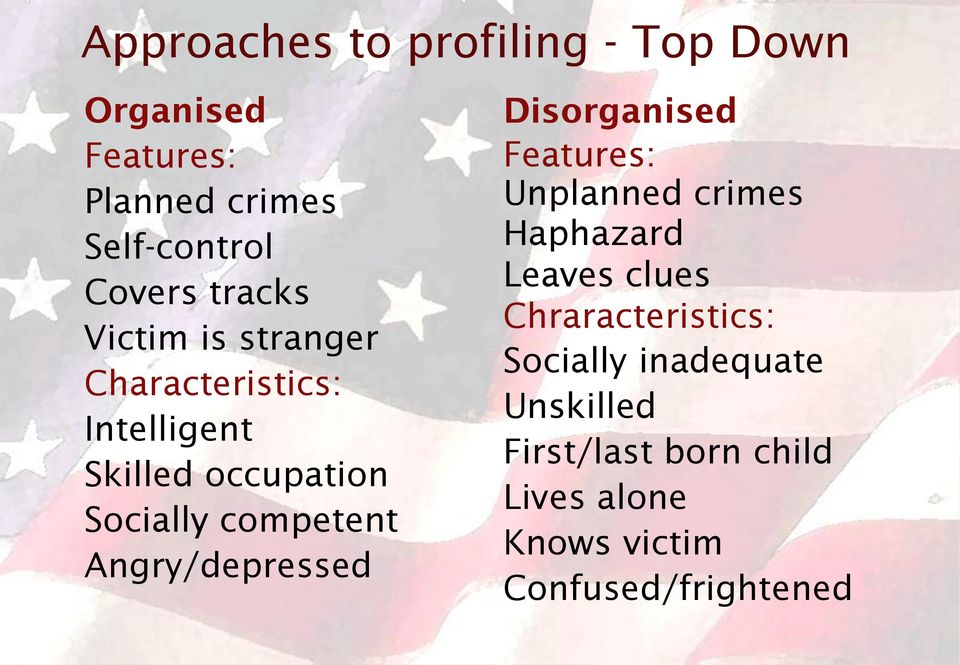 The Top-Down Approach
The Top-Down Approach
Offender profiling is a behavioural investigative tool used to aid the police/FBI in capturing or narrowing down a list of potential suspects. Profilers are called in to high profile cases to work alongside the police, they analyse the crime scene and witness reports and advise on interview techniques as well as developing potential hypotheses (predictions) about the likely characteristics of the offender.
The top down profiling dichotomy of organised and disorganised typologies of offenders was developed by Douglas and Ressler. They interviewed 36 convicted criminals, including Ted Bundy and Charles Manson (Original Journal link – https://vault.fbi.gov/Criminal%20Profiling/Criminal%20Profiling%20Part%203%20of%207). From these interviews they developed a template to match the crime and crime scene with the potential offender. Profilers, after viewing the evidence and crime scene advise on the likelihood of the offender being of organised personality and behavioural type or disorganised.
 There are four main stages employed by the FBI in profile construction
There are four main stages employed by the FBI in profile construction
- Data assimilation – review of evidence
- Crime scene classification – dichotomy of organised or disorganised
- Crime reconstruction – behaviour of victim and testing of hypotheses based on classification
- Profile generation – personality and likely characteristics of the offender
Profiling has captured people’s attention probably due mostly to media representation of it being quite glamorous and magical!
Good TV associated with the top down approach – Criminal Minds (Sky), To catch a Killer (Netflix), Silence of the Lambs (18 certificate), UK Cracker
https://www.huffingtonpost.co.uk/entry/americas-most-notorious-criminals_n_3761487
http://www.apa.org/monitor/julaug04/criminal.aspx


The Bottom-Up Approach
The Bottom-up approach is the British investigative tool for aiding the police in catching and narrowing down suspect lists. It is far more data driven than the top-down approach and is more heavily grounded in psychological theory. David Canter of Liverpool University is the psychologist associated with the bottom up approach and with its successful application (Railway Rapist). Canter looks at five factors: interpersonal coherence, time and place significance, criminal characteristics, criminal career and forensic awareness. The aim of bottom up profiling to establish patterns of behaviour that are likely to occur across crime scenes. It is particularly good at identifying if crimes are linked based on re-occurring characteristics of the crime scene and behaviour of the offender (inter-personal coherence).
Geographical profiling
The video below gives a nice clear explanation of geographical profiling. Some key terminology to note down – Marauder and commuter.
Canter successfully profiled the railway rapist, a case in the 1980s that police could not solve due to the amount of potential suspects. Canter was able to assist in reducing the suspect list therefore prioritising persons of interest. This led to the successful capturing of John Duffy and later his accomplice. The following video is a documentary about the case.
Interesting extras on profiling
The following video is part one of five – it takes you through both systems (Top down, bottom up) and brings in a lot of interesting AO3 points.
Interestingly profiling does not always work and can lead to wrongful convictions.